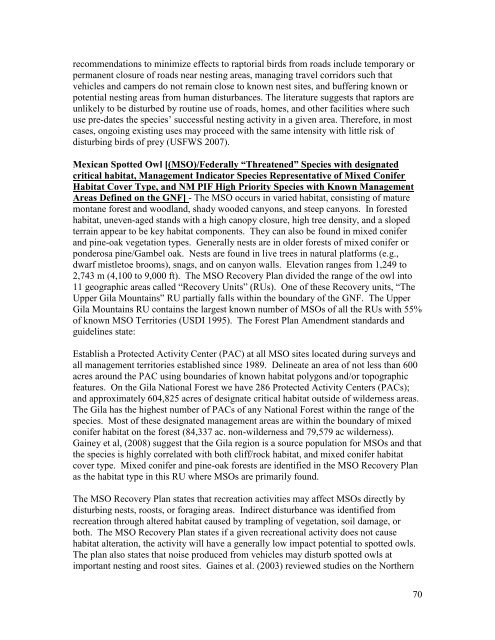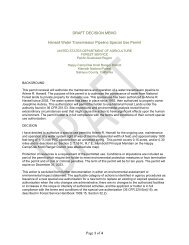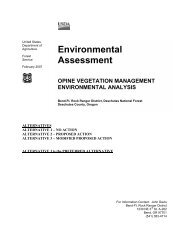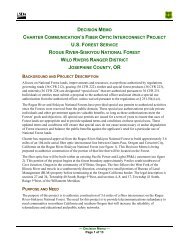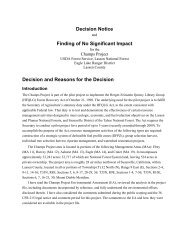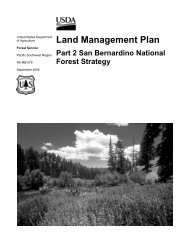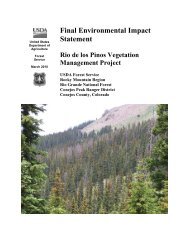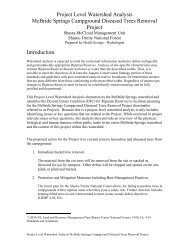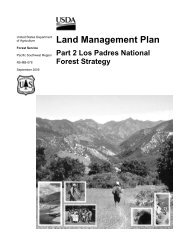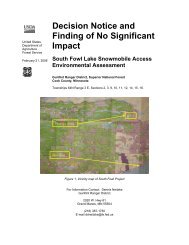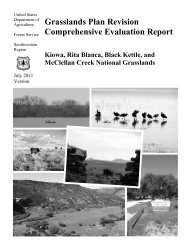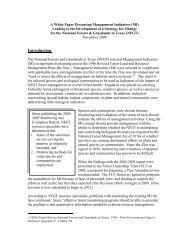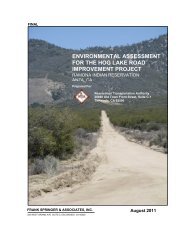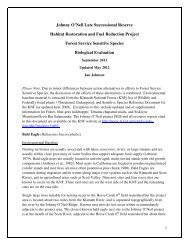Wildlife Specialist report
Wildlife Specialist report
Wildlife Specialist report
Create successful ePaper yourself
Turn your PDF publications into a flip-book with our unique Google optimized e-Paper software.
ecommendations to minimize effects to raptorial birds from roads include temporary or<br />
permanent closure of roads near nesting areas, managing travel corridors such that<br />
vehicles and campers do not remain close to known nest sites, and buffering known or<br />
potential nesting areas from human disturbances. The literature suggests that raptors are<br />
unlikely to be disturbed by routine use of roads, homes, and other facilities where such<br />
use pre-dates the species’ successful nesting activity in a given area. Therefore, in most<br />
cases, ongoing existing uses may proceed with the same intensity with little risk of<br />
disturbing birds of prey (USFWS 2007).<br />
Mexican Spotted Owl [(MSO)/Federally “Threatened” Species with designated<br />
critical habitat, Management Indicator Species Representative of Mixed Conifer<br />
Habitat Cover Type, and NM PIF High Priority Species with Known Management<br />
Areas Defined on the GNF] - The MSO occurs in varied habitat, consisting of mature<br />
montane forest and woodland, shady wooded canyons, and steep canyons. In forested<br />
habitat, uneven-aged stands with a high canopy closure, high tree density, and a sloped<br />
terrain appear to be key habitat components. They can also be found in mixed conifer<br />
and pine-oak vegetation types. Generally nests are in older forests of mixed conifer or<br />
ponderosa pine/Gambel oak. Nests are found in live trees in natural platforms (e.g.,<br />
dwarf mistletoe brooms), snags, and on canyon walls. Elevation ranges from 1,249 to<br />
2,743 m (4,100 to 9,000 ft). The MSO Recovery Plan divided the range of the owl into<br />
11 geographic areas called “Recovery Units” (RUs). One of these Recovery units, “The<br />
Upper Gila Mountains” RU partially falls within the boundary of the GNF. The Upper<br />
Gila Mountains RU contains the largest known number of MSOs of all the RUs with 55%<br />
of known MSO Territories (USDI 1995). The Forest Plan Amendment standards and<br />
guidelines state:<br />
Establish a Protected Activity Center (PAC) at all MSO sites located during surveys and<br />
all management territories established since 1989. Delineate an area of not less than 600<br />
acres around the PAC using boundaries of known habitat polygons and/or topographic<br />
features. On the Gila National Forest we have 286 Protected Activity Centers (PACs);<br />
and approximately 604,825 acres of designate critical habitat outside of wilderness areas.<br />
The Gila has the highest number of PACs of any National Forest within the range of the<br />
species. Most of these designated management areas are within the boundary of mixed<br />
conifer habitat on the forest (84,337 ac. non-wilderness and 79,579 ac wilderness).<br />
Gainey et al, (2008) suggest that the Gila region is a source population for MSOs and that<br />
the species is highly correlated with both cliff/rock habitat, and mixed conifer habitat<br />
cover type. Mixed conifer and pine-oak forests are identified in the MSO Recovery Plan<br />
as the habitat type in this RU where MSOs are primarily found.<br />
The MSO Recovery Plan states that recreation activities may affect MSOs directly by<br />
disturbing nests, roosts, or foraging areas. Indirect disturbance was identified from<br />
recreation through altered habitat caused by trampling of vegetation, soil damage, or<br />
both. The MSO Recovery Plan states if a given recreational activity does not cause<br />
habitat alteration, the activity will have a generally low impact potential to spotted owls.<br />
The plan also states that noise produced from vehicles may disturb spotted owls at<br />
important nesting and roost sites. Gaines et al. (2003) reviewed studies on the Northern<br />
70


